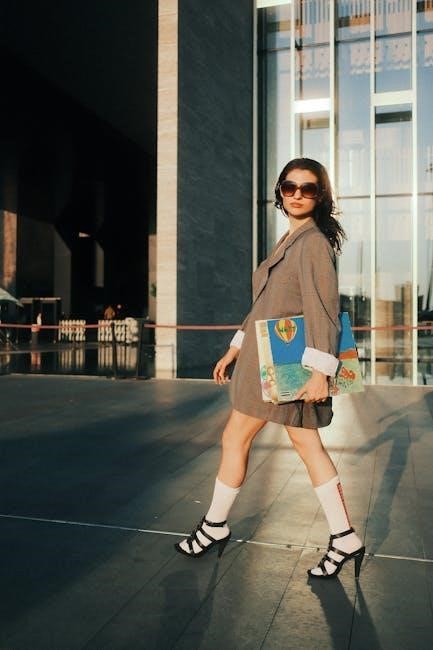Nicola Yoon’s Everything, Everything is a captivating story about a teenage girl isolated by illness, exploring themes of love, identity, and resilience through a unique narrative style․
1․1 Overview of the Book
Everything, Everything by Nicola Yoon is a heartwarming and thought-provoking novel about Madeline, a teenage girl confined to her home due to a rare illness․ Her life transforms when she falls for her neighbor Olly, leading to a complicated romance; The story explores themes of love, identity, and resilience through a unique blend of diary entries, texts, and visual elements․ Available in PDF and other digital formats, this debut novel captivates readers with its innovative style and emotional depth, making it a standout in young adult literature․ Its accessibility in various formats ensures widespread reach and engagement․
1․2 The Author’s Background
Nicola Yoon, the acclaimed author of Everything, Everything, grew up in Jamaica and Brooklyn, later settling in Los Angeles․ Her diverse upbringing influences her storytelling, blending cultural richness and universal themes․ Yoon’s work often explores identity, love, and family dynamics, resonating deeply with readers․ Her debut novel, available in PDF and other formats, showcases her unique voice and innovative narrative style, establishing her as a prominent figure in contemporary young adult literature․ Her ability to weave complex emotions into relatable stories has earned her widespread acclaim and a loyal readership․

1․3 Unique Narrative Style
Nicola Yoon’s Everything, Everything stands out for its experimental narrative structure, combining diary entries, texts, and visual elements․ This approach creates an intimate and engaging reading experience, allowing readers to connect deeply with Madeline’s journey․ The inclusion of charts, lists, and illustrations adds layers to the storytelling, making it visually dynamic․ Available in digital formats like PDF, this style ensures the book’s accessibility and appeal to a broad audience, particularly younger readers who appreciate multimedia storytelling․ Yoon’s innovative technique has been praised for its originality and effectiveness in conveying complex emotions and themes․
Everything, Everything by Nicola Yoon captivates readers with its innovative narrative style, blending diary entries, texts, and visual elements․ The story unfolds through vignettes, charts, and illustrations, creating a dynamic and intimate reading experience․ This multimedia approach allows readers to deeply connect with Madeline’s journey, exploring themes of love, isolation, and identity․ Available in PDF format, the book’s unique structure remains intact, offering a visually engaging experience․ Yoon’s use of diverse storytelling methods sets her apart, making the novel both accessible and memorable for a wide audience․ This style has been praised for its originality and emotional depth․

Plot Summary of “Everything, Everything”
The story follows Madeline, a teenage girl allergic to the outside world, and her complicated romance with Olly, the new neighbor, challenging her isolated existence․
2․1 Main Characters and Their Roles
Madeleine “Maddy” Whittier: The protagonist, an 18-year-old girl with a severe immune disorder, SCID, forcing her to live in a hermetically sealed environment․ Her curiosity and longing for connection drive the story․ Oliver “Olly” Bright: The charming and adventurous new neighbor who challenges Maddy’s sheltered life, sparking a romantic connection that leads to life-changing decisions․ Dr; Pauline Whittier: Maddy’s protective mother and a physician, who prioritizes her daughter’s safety above all else, often creating tension in their relationship․ These characters’ interactions explore themes of love, risk, and self-discovery․
2․2 Key Plot Points and Twists
Maddy, a girl with a rare immune disorder, meets Olly, her charming neighbor, through text messages and observations․ Their relationship deepens, and Maddy risks her health to meet him․ A dramatic twist occurs when Maddy’s health deteriorates after their encounter, revealing the severity of her condition․ Another significant twist comes when Maddy discovers her mother has been lying about her father’s death, reshaping her understanding of her life and family dynamics․ These pivotal moments drive the emotional and narrative progression of the story, highlighting themes of love, risk, and self-discovery․
2․3 Themes Explored in the Story
Everything, Everything delves into themes of love, identity, and resilience, exploring how isolation shapes human connection․ The novel examines the complexities of family relationships and the struggles of living with a chronic illness․ Through Maddy’s journey, Yoon highlights the tension between safety and the desire for human experience, emphasizing the importance of self-discovery and the risks inherent in love․ These themes resonate deeply, offering readers a poignant reflection on life, hope, and the resilience of the human spirit in the face of adversity․

Major Themes in “Everything, Everything”
Everything, Everything explores themes of love, identity, isolation, and resilience, delving into the complexities of human connection, family dynamics, and the struggle to balance safety with the desire for life experiences․
3․1 Love and Romance
Everything, Everything delves into the complexities of first love through Madeline and Olly’s forbidden relationship, exploring themes of vulnerability, trust, and the risks of intimacy․ The narrative captures the beauty of connection despite physical and emotional barriers, blending humor, philosophy, and heartbreak․ Yoon’s portrayal of romance transcends the ordinary, offering a profound reflection on love’s transformative power and its ability to inspire growth and self-discovery․ The story resonates deeply, leaving readers contemplating the balance between safety and the pursuit of heartfelt connections․
3․2 Identity and Self-Discovery
In Everything, Everything, Madeline’s journey is a poignant exploration of identity and self-discovery․ Confined by her illness, she grapples with who she is beyond her isolation․ Through her relationship with Olly and her growing defiance, Madeline challenges her perceptions of life, family, and her own limitations․ The novel highlights the struggle to define oneself amidst external constraints, ultimately revealing the resilience of the human spirit in seeking truth and autonomy․ Yoon’s vivid storytelling captures the emotional depth of finding one’s place in the world despite overwhelming obstacles․
3․3 Family Dynamics and Relationships
Everything, Everything delves into the intricate web of family relationships, particularly Madeline’s bond with her mother․ Her mother’s overprotectiveness, driven by fear of losing her, creates a complex dynamic of love and suffocation․ The arrival of Olly and his family introduces new perspectives, challenging Madeline’s isolation․ Through these interactions, Yoon explores themes of parental sacrifice, trust, and the tension between protection and independence․ The novel highlights how family ties shape identity and the difficult balance between shielding loved ones and allowing them to thrive․
3․4 Health, Isolation, and Survival
In Everything, Everything, Madeline’s rare illness, SCID, confines her to a sterile environment, highlighting the physical and emotional toll of chronic health conditions․ Her isolation is both a survival mechanism and a source of profound loneliness․ Through her journey, Yoon explores the resilience required to survive such constraints, emphasizing the interplay between mental and physical health․ Madeline’s story underscores the human capacity to adapt and find hope, even in the most isolating circumstances, making it a powerful exploration of survival and the quest for normalcy․
Unique Narrative Style and Structure
Everything, Everything features a bold, experimental narrative style, blending vignettes, diary entries, texts, charts, and illustrations to create a visually dynamic and engaging storytelling experience․
4․1 Vignettes, Diary Entries, and Texts
Everything, Everything uniquely combines vignettes, diary entries, and texts to narrate Madeline’s story․ These formats provide intimate insights into her thoughts and emotions, creating a personal connection with readers․ The use of texts and digital communication reflects modern interactions, adding realism․ Diary entries reveal her inner world, while vignettes offer snapshot glimpses of her life․ This blend of narrative techniques makes the story relatable and engaging, allowing readers to experience Madeline’s journey firsthand through diverse and dynamic storytelling methods․
4․2 Use of Visual Elements and Illustrations
Nicola Yoon’s Everything, Everything incorporates visual elements like charts, lists, and illustrations to enhance the narrative․ These visuals break up text, making the story feel dynamic and personal․ They reflect Madeline’s creativity and emotions, offering readers a deeper connection to her world․
The illustrations and designs within the book add a layer of intimacy, mirroring Madeline’s inner thoughts and artistic expressions․ This visual storytelling makes the novel engaging and memorable, blending words with images to create a unique reading experience․
4․3 Experimental Narrative Structure
Everything, Everything stands out for its innovative narrative structure, blending diary entries, texts, charts, and illustrations․ This non-linear approach creates a dynamic, modern feel, mirroring Madeline’s fragmented yet vibrant inner world․ The use of multiple formats enhances storytelling, offering readers a deeper connection to Madeline’s experiences and emotions․ Yoon’s experimental style challenges traditional narrative conventions, making the book feel fresh and engaging․ This structure not only reflects Madeline’s creativity but also underscores the book’s themes of identity and resilience, providing a unique reading experience․
Availability of “Everything, Everything” in PDF Format

Nicola Yoon’s Everything, Everything is widely available in PDF format through various online sources, including direct downloads and reading platforms, making it easily accessible worldwide․
5․1 Sources for Downloading the PDF
The PDF version of Everything, Everything can be downloaded from various sources, including online libraries, eBook platforms, and direct download links․ Popular options include Telegram channels and online book repositories, which offer free access to the file․ Additionally, some websites provide direct download links for the PDF, making it easily accessible to readers worldwide․ Always ensure to verify the source’s reliability to avoid unauthorized or unsafe downloads․
5․2 Legal and Ethical Considerations
Downloading Everything, Everything in PDF format raises legal and ethical concerns․ Ensure the source is authorized to distribute the book to avoid copyright infringement․ Pirated downloads harm authors and publishers, who rely on sales for income․ Always verify the legitimacy of the source and consider purchasing the book or using legal platforms like libraries or eBook stores to support Nicola Yoon and the publishing industry ethically․

Critical Reception and Reviews
Everything, Everything received widespread acclaim for its unique narrative and emotional depth, earning a 4/5 rating and praise from readers and critics alike․
6․1 Positive Reviews and Praise
Nicola Yoon’s Everything, Everything has garnered widespread critical acclaim for its innovative narrative style and emotional depth․ Reviewers praise the book’s ability to balance lighthearted moments with profound themes, resonating deeply with readers․ The unique blend of vignettes, diary entries, and illustrations enhances the storytelling, making it a standout in young adult literature․ With a 4/5 rating and over 1,500 reviews, the novel is celebrated for its relatable characters and heartfelt exploration of love, identity, and resilience․ Fans and critics alike commend Yoon’s fresh voice and the book’s universal appeal․
6․2 Critical Analysis and Mixed Opinions
While Everything, Everything has been praised for its unique narrative style, some critics argue that the experimental format, including vignettes and diary entries, can feel gimmicky at times․ A few reviewers noted that the romance, though heartfelt, occasionally leans into clichés․ However, the books exploration of identity, isolation, and resilience is widely commended for its emotional depth and relatability․ Despite mixed opinions on pacing and character development, the novel remains a significant contribution to young adult literature, sparking important discussions about love and vulnerability․
Main Characters in “Everything, Everything”
Maddy, a girl with a severe immune disorder, and Olly, the charming boy next door, form the core of this emotional journey, driven by their unique connection and shared discoveries․
7․1 Madeline “Maddy” Whittier
Maddy, the protagonist, is a brilliant, 18-year-old girl suffering from a rare immune disorder, forcing her to live in a sterile, isolated environment․ Her world is confined to her home, where she spends most of her time reading, learning, and dreaming of the outside․ Despite her physical limitations, Maddy’s curiosity and determination drive her to challenge the boundaries set by her overprotective mother․ Through her diary entries, texts, and inner monologues, Maddy’s voice shines, revealing her wit, resilience, and deep longing for connection and freedom․ Her journey is one of self-discovery, love, and the pursuit of a life beyond her bubble․
7․2 Olly Bright
Olly Bright is the charming and mysterious new neighbor who captivates Maddy with his unconventional charm and humor․ His arrival disrupts Maddy’s sheltered world, sparking a deep connection that evolves through texts, window gestures, and shared stories․ Olly’s adventurous spirit and philosophical outlook challenge Maddy to question her reality․ Despite his own family struggles, Olly embodies resilience and kindness, making him a compelling and relatable character․ His relationship with Maddy is central to the story, exploring themes of love, risk, and the beauty of human connection in unexpected ways․
7․3 Secondary Characters and Their Impact
Secondary characters like Maddy’s mother, Dr․ Whittier, and Carla, her nurse, play pivotal roles in shaping Maddy’s world․ Dr․ Whittier’s overprotectiveness stems from grief, influencing Maddy’s isolation, while Carla offers warmth and support, bridging her to the outside․ Maddy’s father, though deceased, leaves a lasting impact through his absence․ The Bright family, particularly Olly’s sister, adds depth to the narrative․ These characters highlight themes of family, loss, and resilience, enriching the story’s emotional landscape and contributing to Maddy’s journey of self-discovery and growth․ Their roles are essential to the plot’s progression and character development․
Everything, Everything is a poignant exploration of love, isolation, and self-discovery․ Its unique narrative and emotional depth leave a lasting impact, making it a beloved read․
8․1 Overall Impact of the Book
Everything, Everything leaves a profound impact, blending emotional depth with a unique narrative style․ Its exploration of love, isolation, and identity resonates deeply, making readers reflect on life’s risks and beauty․ The book’s ability to evoke laughter and tears highlights its universal appeal․ Yoon’s innovative storytelling, through vignettes and diary entries, adds to its charm․ The novel’s success lies in its relatability, making it a cherished read for diverse audiences․ Its poignant message about embracing life’s uncertainties ensures a lasting impression on readers worldwide․
8․2 Recommended Audience
Everything, Everything is ideal for young adult readers who enjoy contemporary and realistic fiction․ Its themes of love, identity, and resilience resonate deeply with teenagers and adults alike․ The unique narrative style, blending vignettes and diary entries, appeals to fans of innovative storytelling․ The books emotional depth and relatable characters make it a great choice for readers seeking a heartfelt and thought-provoking experience․ Its availability in PDF format also ensures accessibility for a wide audience, making it a popular pick for book clubs and individual readers globally․
The Book’s Adaptation into a Movie

The film adaptation of Everything, Everything, released in 2017, directed by Stella Meghie, stars Amandla Stenberg and Ansel Elgort․ It captures the book’s emotional depth and romance, receiving positive reviews for its faithful adaptation and heartfelt storytelling, appealing to fans of the novel and romantic dramas alike․
9․1 Differences Between the Book and Movie
While the movie adaptation of Everything, Everything remains largely faithful to the book, some differences stand out․ The film simplifies the narrative, omitting the unique vignettes and diary entries that make the book distinctive․ The ending is also slightly altered, providing a more conventional resolution compared to the book’s open conclusion․ Additionally, the movie focuses more on the romance, while the book delves deeper into Madeline’s internal struggles and philosophical reflections․ Despite these changes, the emotional core of the story remains intact, preserving the heartwarming and heart-wrenching essence of Yoon’s original work․

9․2 Reception of the Movie Adaptation
The movie adaptation of Everything, Everything received mixed reviews from critics and audiences․ While many praised the chemistry between the leads and the visually appealing portrayal of Madeline’s isolated world, others felt the film oversimplified the book’s complex themes and unique narrative structure․ Critics noted that the movie lacked the depth and philosophical undertones present in the novel, particularly in its handling of Madeline’s internal struggles․ Despite this, the film performed reasonably well at the box office and was appreciated for its heartfelt and visually engaging take on the story․

Cultural and Social Impact
Everything, Everything has enhanced diversity in young adult literature, offering a unique Caribbean female voice and influencing conversations about identity, isolation, and love in modern society․
10․1 Representation in Media
Everything, Everything has significantly impacted media representation by introducing a Caribbean female protagonist, Madeline Whittier, and showcasing diverse cultural experiences․ Nicola Yoon’s Jamaican heritage enriches the narrative, offering a fresh perspective in young adult literature․ The book’s success has paved the way for more inclusive storytelling, emphasizing the importance of diverse voices․ Its unique blend of vignettes, diary entries, and visual elements further highlights the authenticity of Maddy’s journey, resonating with readers worldwide and inspiring a more representative media landscape․
10․2 Influence on Young Adult Literature
Everything, Everything has left an indelible mark on young adult literature by redefining storytelling through its innovative narrative structure and diverse representation․ Nicola Yoon’s use of vignettes, diary entries, and visual elements has inspired authors to experiment with non-traditional formats․ The book’s Caribbean protagonist, Madeline Whittier, brings much-needed diversity to the genre, encouraging publishers to seek out more inclusive voices․ Its success has sparked conversations about identity, love, and resilience, making it a benchmark for contemporary YA fiction and paving the way for future stories that celebrate individuality and cultural richness․
Educational and Discussion Value
Everything, Everything offers rich educational value, sparking discussions on identity, health, and relationships․ Its unique narrative style encourages critical thinking, making it a valuable classroom resource․
11․1 Classroom Discussions and Themes
Everything, Everything is a valuable tool for classroom discussions, exploring themes of identity, isolation, and first love․ Its unique narrative style, blending vignettes, diary entries, and texts, encourages students to analyze storytelling methods․ The book’s focus on resilience and self-discovery sparks conversations about personal growth and societal expectations; Teachers can guide discussions on themes like health challenges, family dynamics, and the complexities of love, fostering empathy and critical thinking․ The novel’s relatable protagonist and contemporary issues make it an engaging choice for adolescent readers․
11․2 Reading Guides and Study Materials
Reading guides and study materials for Everything, Everything are widely available online, offering deeper insights into the novel․ PDF guides include chapter summaries, discussion questions, and thematic analyses, helping students engage with the story․ These resources highlight the books unique narrative style, blending diary entries and texts, and explore themes like identity and isolation․ Educators can use these materials to foster analytical thinking and comprehension․ Additionally, study aids provide vocabulary lists, character analyses, and essay prompts, enriching the reading experience and encouraging a deeper understanding of Yoons work․

Fan Reactions and Community Engagement
Fans of Everything, Everything have created vibrant communities online, sharing fan art, reviews, and discussions․ The books unique style and emotional depth inspire creative responses and engagement․
12․1 Fan Art and Creative Responses
Fans of Everything, Everything have expressed their love for the book through vibrant fan art and creative interpretations․ Digital illustrations, sketches, and fan fiction inspired by Madeline and Olly’s story have flourished online․ The books unique narrative style, including its visual elements, has encouraged fans to experiment with art forms, blending text and imagery․ Many fans share their work on social media, fostering a sense of community and mutual appreciation․ These creative responses reflect the emotional impact of the story and its ability to inspire personal expression and connection․
12․2 Online Discussions and Forums
Online forums and discussions about Everything, Everything reveal a vibrant community of fans sharing insights and opinions․ Platforms like Reddit and Goodreads host threads where readers analyze the books themes, characters, and unique narrative style․ Fans often discuss Madeline’s journey, the complexity of her relationships, and the emotional depth of the story․ These spaces also serve as hubs for sharing resources, such as eBook versions and reading guides․ The passionate discussions highlight the books ability to connect readers and inspire meaningful conversations about love, identity, and resilience․





